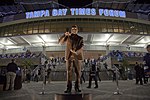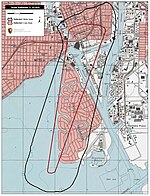Amalie Arena

Amalie Arena (officially stylized as AMALIE Arena) is a multipurpose arena in Tampa, Florida, that has been used for ice hockey, basketball, arena football, concerts, and other events. It is mainly used as the home for the Tampa Bay Lightning of the National Hockey League. The building opened in 1996 and was originally known as the Ice Palace. In August 2002, the building's naming rights were sold to the St. Petersburg Times, which became the Tampa Bay Times in January 2012; accordingly, the arena was known as the St. Pete Times Forum (2002–2012) and Tampa Bay Times Forum (2012–2014). In September 2014, the arena was renamed Amalie Arena when the naming rights were transferred to Amalie Oil Company.
Excerpt from the Wikipedia article Amalie Arena (License: CC BY-SA 3.0, Authors, Images).Amalie Arena
Channelside Drive, Tampa Harbour Island
Geographical coordinates (GPS) Address Website External links Nearby Places Show on map
Geographical coordinates (GPS)
| Latitude | Longitude |
|---|---|
| N 27.942777777778 ° | E -82.451944444444 ° |
Address
Amalie Arena
Channelside Drive 401
33602 Tampa, Harbour Island
Florida, United States
Open on Google Maps








